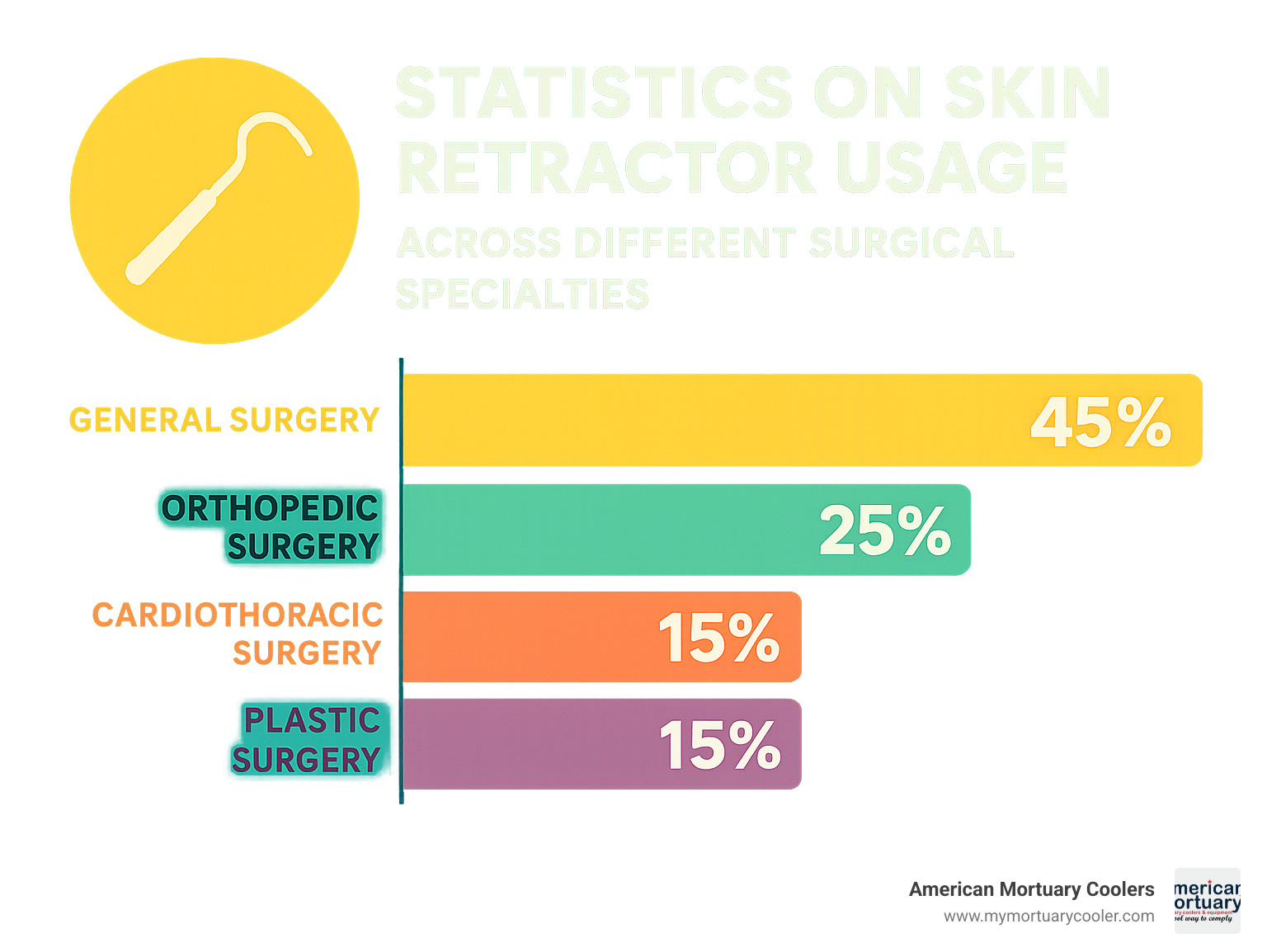
All About Skin Retractors: Uses, Types, and Benefits
Understanding Surgical Skin Retractors
A skin retractor is a surgical instrument designed to hold back the edges of a wound or incision to provide clear access and visibility to the surgical site. These essential tools help surgeons work with precision while minimizing tissue damage.
What is a skin retractor?
- A surgical instrument that holds tissue away from the operative field
- Available in handheld and self-retaining designs
- Typically made of stainless steel or titanium
- Features prongs or hooks that gently hold tissue without crushing it
- Prices range from $6 (economy models) to $21+ (premium versions)
Surgical retractors have ancient origins, with evidence of hook-like instruments dating back to Stone Age tools. Today's modern skin retractors create and maintain surgical exposure while reducing the need for manual tissue handling. They're essential in procedures ranging from minor dermatological surgeries to complex operations.
The primary advantage of skin retractors over other instruments like forceps is their ability to hold tissue firmly without the crushing effect that can damage delicate structures. This atraumatic approach is particularly important in plastic surgery and wound repair.
I'm Mortuary Cooler, a national supplier with expertise in surgical instruments including skin retractors used in both surgical and post-mortem procedures.
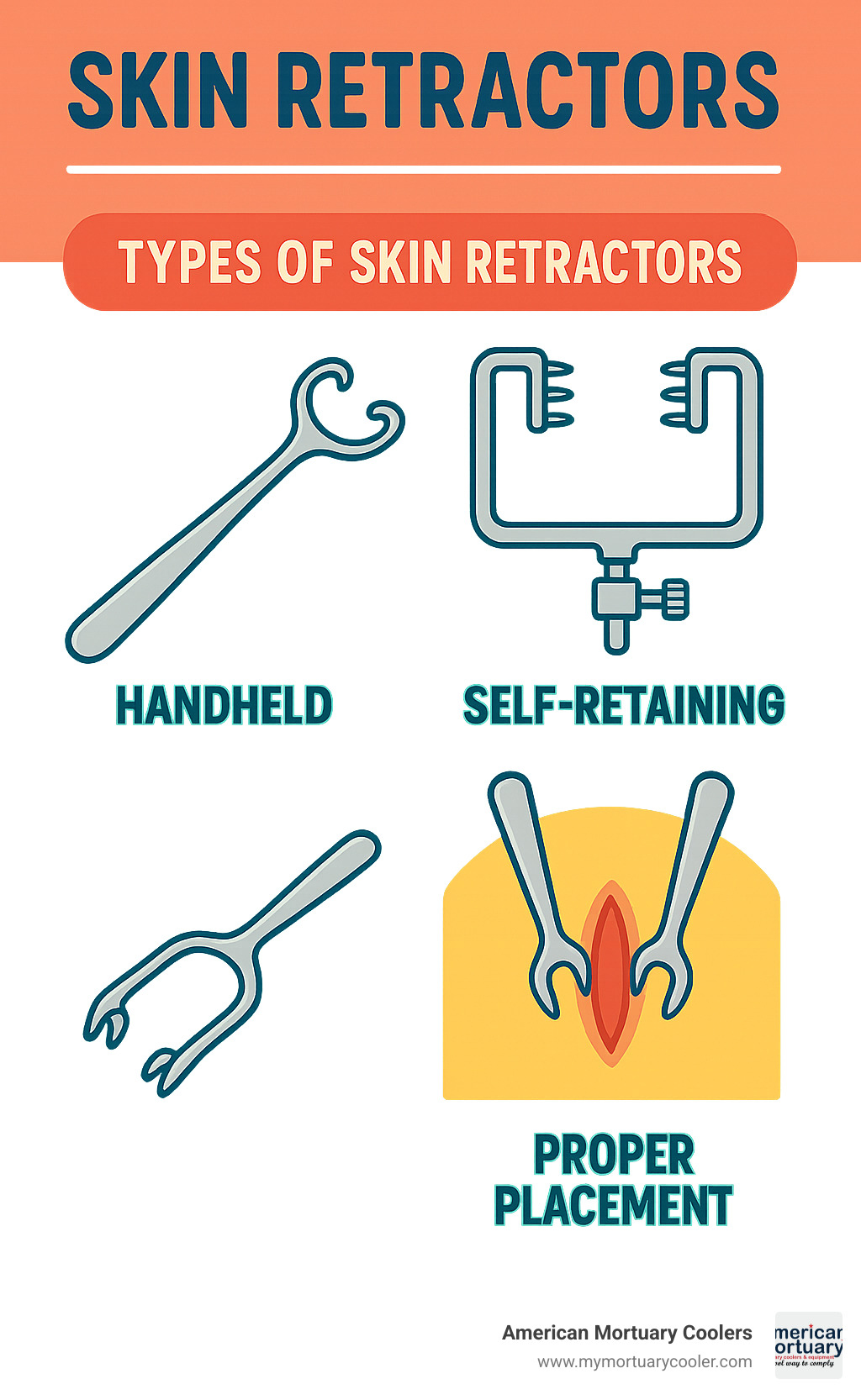
Skin Retractor Basics: Definition and Surgical Function
When you think about surgical tools, many people imagine scalpels or clamps. But there's an unsung hero in every operating room – the humble skin retractor. This instrument does something simple yet essential: it gently holds back the edges of an incision or wound, giving surgeons the clear view they need.
Unlike tools designed to cut, clamp, or grasp tissues, skin retractors have a singular focus – creating and maintaining visibility throughout a procedure. This might sound straightforward, but proper exposure is truly the foundation of successful surgery.
When a skin retractor is doing its job well, surgeons can clearly identify important anatomical structures, perform precise work with confidence, and avoid accidentally damaging surrounding tissues. This improved visibility doesn't just improve safety – it also makes procedures more efficient.
In surgical instruments, skin retractors belong to the "Retracting and Exposing" family – one of the four fundamental categories alongside cutting, clamping, and grasping tools. Their design prioritizes being gentle on tissues while providing stable, reliable retraction.
Origins and Evolution of the Skin Retractor
The story of skin retractors stretches back surprisingly far. Archaeological findings suggest our earliest ancestors fashioned hooks from antlers and bones, some likely used for primitive surgical needs. By the time of the Roman Empire, metalworkers were crafting specialized hooks for medical procedures.
In the 7th century, a physician named Paul of Aegina documented specialized tongue spatulas and hooks for tonsil surgeries. Fast forward to 1904, when Jan Mikulicz-Radecki introduced the first hinged rib-spreading retractor. Then in 1936, Enrique Finochietto standardized the modern hinged rib spreader design that continues to influence instruments today.
The mid-20th century brought self-retaining mechanisms using clever ratchets, springs, and worm gears that freed surgeons' hands for other tasks. Today's innovations focus on lighter materials, better ergonomics, and smart additions like built-in fiber-optic lighting.
Key Surgical Roles of a Skin Retractor
Skin retractors serve several critical functions across virtually all surgical specialties:
Incision Management is perhaps their most fundamental role – holding back incision edges to maintain access to deeper structures. This becomes especially important when surgeons need precise depth perception and visualization.
During Flap Elevation procedures like reconstructive surgery or Mohs micrographic surgery, gentle skin retractors lift delicate skin flaps without compromising their crucial blood supply.
In trauma cases, Wound Exploration with retractors allows thorough examination of wound beds. Surgeons can spot foreign bodies, assess which tissues remain viable, and locate bleeding vessels that need attention.
For Dermatologic Closure, especially in cosmetic or plastic surgery, skin hooks help surgeons perfectly align wound edges for meticulous suturing that minimizes scarring.
At American Mortuary Coolers, we understand that precise tissue handling matters across many fields. The same principles that make skin retractors indispensable in operating rooms also apply in forensic and mortuary settings.
For more scientific background on surgical retractors and their applications, you can explore this research on surgical retractors from Science Direct.
Types and Designs of Skin Retractors
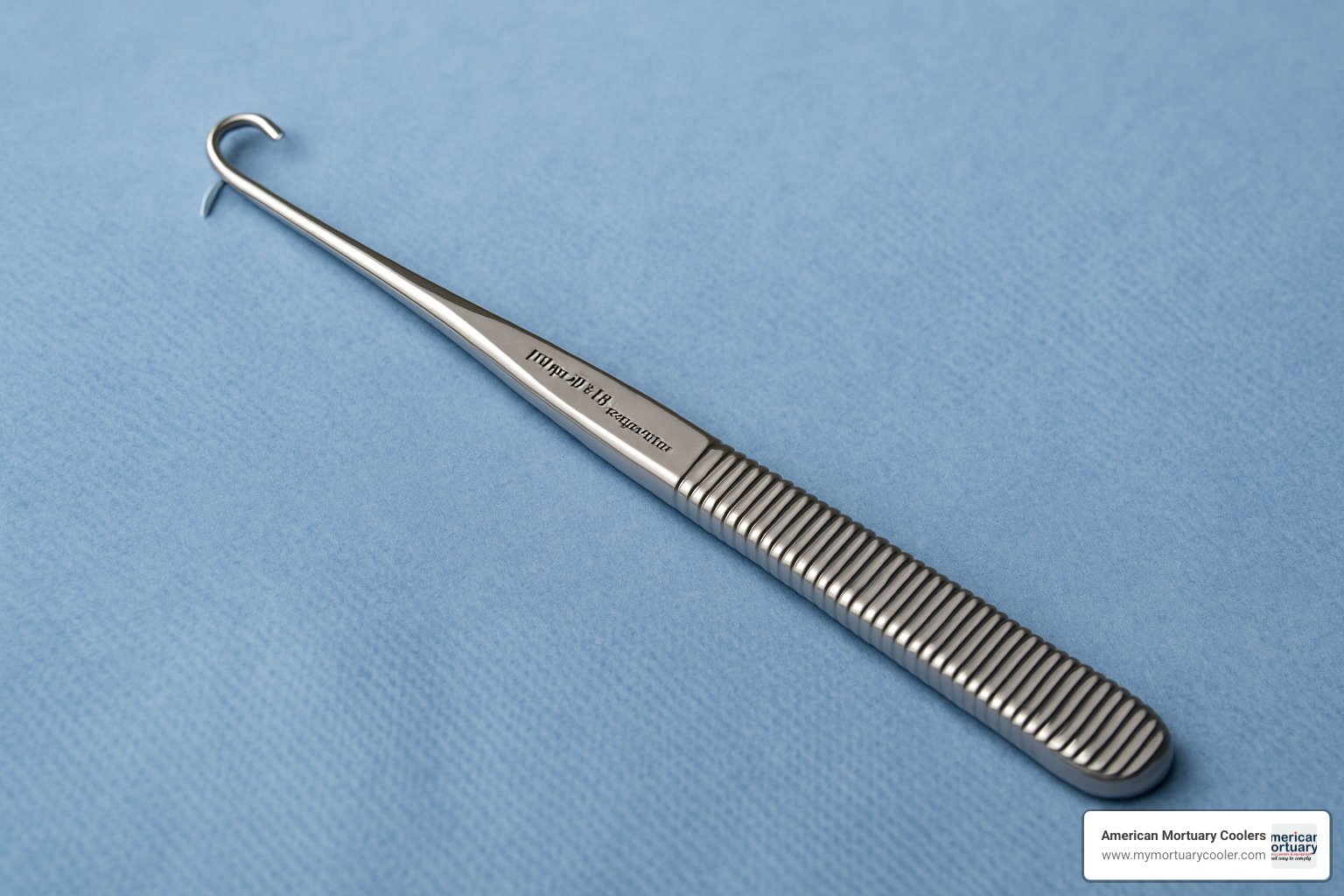
When you peek inside a surgeon's toolkit, you'll find a variety of skin retractors, each with its own special purpose. It's a bit like how different kitchen tools serve different cooking needs.
Skin retractors come in two main families. Handheld retractors require the steady hand of a surgeon or assistant throughout the procedure. Then there are the clever self-retaining retractors that can maintain their position without continuous holding.
This distinction matters tremendously in the operating room. Self-retaining designs can reduce the number of people needed around the operating table, potentially lowering infection risks and improving workflow efficiency.
Let's see how these retractors compare to their cousin, the forceps:
| Feature | Skin Retractors | Forceps |
|---|---|---|
| Tissue Contact | Point contact via hooks or prongs | Broad surface contact |
| Tissue Trauma | Minimal (atraumatic) | Potential crushing effect |
| Holding Mechanism | Hooks or blades | Serrated jaws |
| Primary Function | Exposure and retraction | Grasping and manipulation |
| Common Materials | Stainless steel, titanium | Stainless steel, titanium |
| Price Range | $6-$21+ | $10-$100+ |
| Sterilization | Standard autoclave | Standard autoclave |
For more detailed information about forceps and their handling techniques, you might find this complete guide to forceps types and uses helpful.
Handheld Skin Retractor Variants
The world of handheld skin retractors is diverse, with each design addressing specific surgical needs.
The Joseph Skin Hook is perhaps the most recognizable. Typically 6.25 inches long with a comfortable knurled handle for better grip, these come in single or double prong designs. Budget-conscious buyers can find economy models starting around $6, while premium versions might cost up to $21.
If versatility is what you're after, the Senn Retractor offers a two-for-one deal with a skin hook on one end and a rake-like retractor on the other. Plastic surgeons particularly appreciate this approach during intricate procedures.
For rhinoplasty specialists, the Tebbetts Nasal Retractor is a game-changer. Its grooved, concave tip nestles perfectly against the nasal dorsum while being gentle on delicate nasal tip skin.
The Army-Navy Retractor might technically be designed for deeper tissues, but surgeons often reach for this double-ended workhorse when retracting skin during procedures like appendectomies. Meanwhile, the Ribbon Retractor offers a completely different approach with its flat, malleable design.
Self-Retaining Skin Retractor Options
Self-retaining skin retractors are the unsung heroes of long surgical procedures, preventing assistant fatigue and maintaining consistent exposure.
The Heiss Self-Retaining Skin Retractor features adjustable arms that can be positioned just so, making it ideal for procedures requiring sustained access to a specific area.
With its ratcheted arms and multiple prongs, the Weitlaner Retractor holds tissue back with reliable precision. Available in various sizes to accommodate different procedure depths.
Modern innovation shines in the Galaxy II System with its lightweight ring frame and attachable hooks. It's been CO₂ neutral since 2018, for the environmentally conscious surgical team.
Most self-retaining retractors employ either ratchet systems (allowing step-by-step adjustments) or spring mechanisms (providing constant gentle tension) to maintain their position.
Common Skin Retractor Blade Designs
The business end of a skin retractor comes in several thoughtful configurations.
Single prong designs offer precision for delicate tissues or small incisions, providing focused retraction at exactly one point. When more stability is needed, double prong versions distribute tension across a slightly wider area of tissue.
The choice between sharp hooks and blunt hooks depends on the specific needs of the procedure. Sharp hooks penetrate the dermis for secure retraction but require careful placement. Blunt hooks rely on friction and proper positioning rather than penetration.
Width choices in retractor blades range from narrow (perfect for the delicate work of plastic surgery) to wide (ideal for larger exposures in general surgery).
At American Mortuary Coolers, we understand that proper instrument selection matters across all medical and mortuary settings. For more information about surgical instruments and their care, you might also be interested in our practical guide to comparing scalpel blade options.
Proper Technique, Safety, and Maintenance
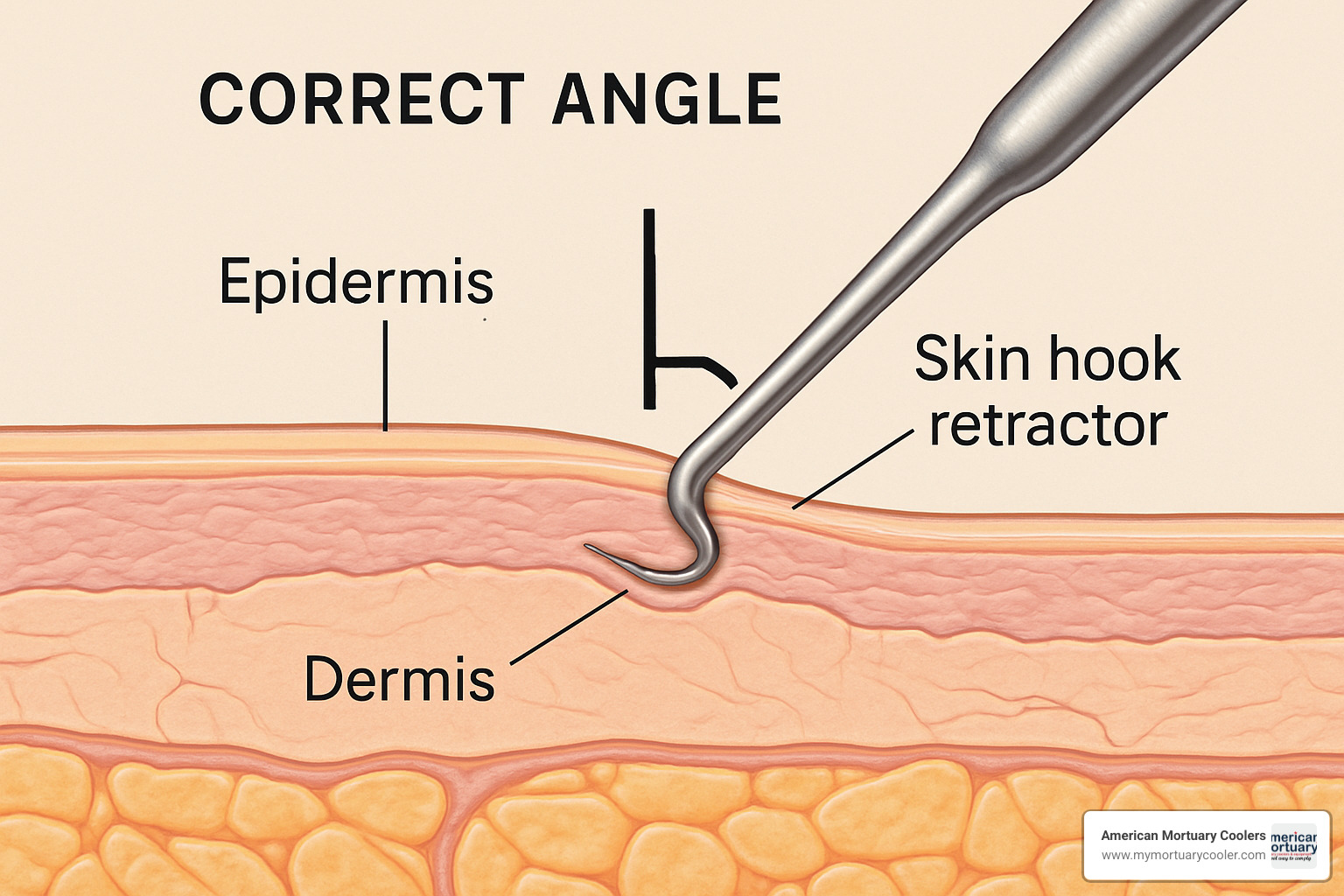
Using a skin retractor requires finesse, proper technique, and an understanding of delicate human tissue. Whether you're a seasoned surgeon or new to the field, mastering the proper handling of these essential tools ensures better outcomes for patients and longer life for your instruments.
Using a Skin Retractor to Minimize Tissue Trauma
When I first learned to use a skin retractor, my mentor emphasized one golden rule: respect the tissue. This means applying only the gentlest traction necessary to achieve visualization. You're looking for that sweet spot where you can see clearly without causing the tissue to blanch or distort.
The 90-degree rule is your best friend when handling skin hooks. By maintaining a right angle between the hook and tissue surface, you distribute force evenly and significantly reduce tearing risk. Think of it like carrying a heavy grocery bag – hold it at the proper angle and the weight distributes evenly; hold it wrong and the bag tears.
With self-retaining retractors, patience pays off. Increase tension gradually in small increments rather than cranking to maximum retraction immediately. This gives tissue time to accommodate, much like how we ease into a stretch rather than forcing it.
Strategic placement makes all the difference. Position your skin retractor at structurally sound points that can handle the necessary tension. Avoid placing hooks near fragile wound edges, compromised tissue, or directly over vital structures like nerves or vessels.
For longer procedures, tissues need "breathing room" too. Periodically release and reposition your retractors to prevent prolonged pressure in any single area. This simple habit maintains tissue perfusion and prevents ischemic damage that can complicate healing.
Cleaning, Sterilizing & Storing Skin Retractors
The life of your skin retractor begins anew after each use – but only if you care for it properly. Start with an immediate cool water rinse after use. This removes contaminants before they can dry and become difficult to remove. Avoid hot water at this stage, as it can coagulate proteins and create a stubborn mess.
A good enzymatic soak is like a spa treatment for your instruments. These specialized cleaners break down biological materials that might be invisible to the naked eye. Follow the manufacturer's instructions for concentration and timing.
Ultrasonic cleaning reaches the places your scrubbing can't. Those tiny crevices in hinges, ratchets, and serrations harbor debris that manual cleaning might miss. This step is particularly important for complex self-retaining models with multiple moving parts.
Before sterilization, take a moment for thorough inspection. Look for bent hooks, misaligned jaws, or early signs of corrosion. Pay special attention to hinges and ratchets on self-retaining models. A compromised instrument shouldn't make it to the next procedure.
Most stainless steel retractors handle standard autoclave cycles beautifully (270°F/132°C for 4 minutes), but always verify with manufacturer guidelines. Some specialized instruments with non-metal components may require different protocols.
Complications From Improper Skin Retractor Use
Even the best tools can cause harm in untrained hands. Skin tearing from excessive tension or improper hook placement is a real risk, particularly in elderly patients or those with compromised skin integrity. The resulting damage can extend healing time and worsen scarring outcomes.
Nerve injury represents another significant concern. Prolonged or excessive pressure from skin retractors can cause temporary or permanent nerve damage, resulting in numbness, tingling sensations, or chronic pain that far outlasts the procedure itself.
Compromised blood supply from aggressive retraction leads to delayed wound healing, increased infection risk, and suboptimal scarring. The tissues need adequate circulation to heal properly – something easily disrupted by overzealous retraction.
At American Mortuary Coolers, we understand these principles apply equally across surgical and post-mortem contexts. While our focus is providing the finest mortuary refrigeration solutions, we recognize that proper instrument handling is fundamental to dignity and safety in all medical settings.
Materials, Innovations, and Cost Considerations
The world of skin retractors continues to evolve with exciting advancements in materials, design, and manufacturing. These innovations aren't just about shiny new tools—they're making real differences in surgical outcomes while balancing cost-effectiveness and environmental responsibility.
When you pick up a modern skin retractor, you're likely holding one made from medical-grade stainless steel (typically 316L). This remarkable material remains the gold standard due to its perfect balance of durability, corrosion resistance, and ability to withstand countless sterilization cycles.
For surgeons spending hours in delicate procedures, titanium alloy retractors offer a welcome relief. Significantly lighter than their stainless steel counterparts while maintaining comparable strength, these instruments reduce hand fatigue during surgical sessions.
The single-use revolution has also reached the skin retractor market, with high-grade medical polymers creating disposable options that offer sufficient strength for short procedures while eliminating cross-contamination concerns.
When it comes to price, skin retractors run the gamut from basic to premium:
- A simple economy single-prong skin hook might cost around $6
- A precision German-manufactured single-prong hook jumps to about $19
- The double-prong German-made versions reach approximately $21
- Self-retaining systems can range anywhere from $50 to well over $500
Smart facility managers look beyond the sticker price to consider the full picture: sterilization costs, instrument lifespan, and potential complications from reuse all factor into the true cost of ownership.
Recent Advances in Skin Retractor Technology
The humble skin retractor has come a long way from its ancient origins, with several innovations making surgical life better:
Built-in lighting has been a game-changer for deep surgical fields. Models like the Tebbetts™ Rhinoplasty Retractor and Galaxy II Lux Connect brilliantly combine retraction with targeted illumination, turning these instruments into two-in-one solutions.
Your hands will thank you for the ergonomic revolution happening in handle design. Textured surfaces, contoured shapes, and lightweight materials all work together to reduce hand fatigue during those long procedures where every millimeter matters.
In the minimally invasive surgery world, low-profile frames on self-retaining systems are making a big difference. These slimmer designs reduce interference with other instruments while still maintaining the exposure surgeons need.
Environmental consciousness has also reached the skin retractor market. The Galaxy II system, for instance, has been CO₂ neutral since 2018—a reflection of growing awareness about healthcare's environmental footprint.
Choosing the Right Skin Retractor for Your Procedure
Selecting the perfect skin retractor is a bit like choosing the right tool for a home project—it makes all the difference in your results.
Procedure depth should guide your choice. Superficial work like dermatologic surgery might only need simple skin hooks or small self-retaining retractors, while deep abdominal procedures demand longer instruments with adequate reach and stability.
Patient anatomy matters tremendously. Pediatric patients need smaller, more delicate retractors; bariatric patients require stronger, longer instruments capable of managing increased tissue thickness; and elderly patients benefit from gentler retraction.
Never underestimate the importance of surgeon preference. Years of training and experience create strong habits—some surgeons swear by the tactile feedback of handheld instruments, while others wouldn't dream of working without the stability of self-retaining systems.
Budget considerations go beyond the initial purchase. Smart buyers look at the complete picture: initial investment versus long-term costs, reprocessing expenses for reusable instruments, and storage requirements.
At American Mortuary Coolers, we understand equipment selection principles apply across both medical and mortuary settings. While our Tennessee-based company focuses primarily on mortuary refrigeration solutions, we bring the same commitment to durability and custom solutions to everything we do.
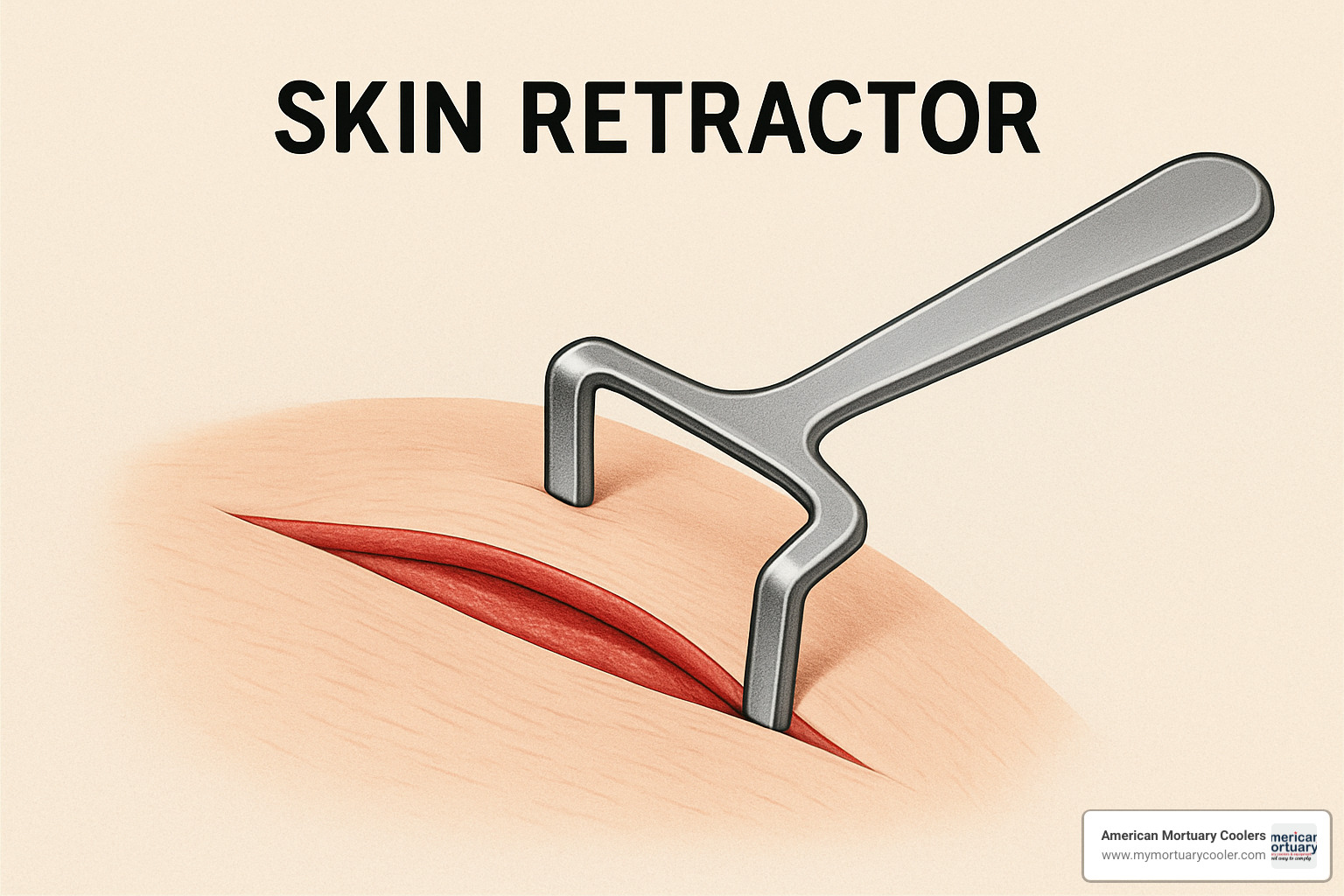
Frequently Asked Questions about Skin Retractors
What makes a skin retractor different from forceps?
When you're working in surgery, the tools you choose make all the difference. Skin retractors and forceps might seem similar at first glance, but they serve fundamentally different purposes in the surgical toolkit.
Skin retractors are your gentle holders – they're specifically designed to pull tissue away from your working area using hooks, prongs, or blades that only touch the tissue at specific points. Think of them as the polite assistant who holds things out of your way without squeezing or damaging them.
Forceps, on the other hand, are your grabbers. They grasp tissue between two opposing jaws, which can create that "crushing" effect we try to avoid with delicate structures. While they're excellent for precisely manipulating tissues, they're not ideal for holding tissue back for extended periods.
The key differences really come down to their purpose. Skin retractors create gentle, sustained exposure with minimal trauma, while forceps offer precise, temporary grasping power. In the operating room, you'll often see both used together – retractors keeping the overall field open while forceps handle the detailed work within that exposed area.
Which surgical procedures rely most on skin retractors?
Skin retractors truly shine in procedures where gentle tissue handling and clear visualization make all the difference in patient outcomes.
In dermatologic surgery, these tools are absolutely essential. During Mohs surgery for skin cancer removal, the surgeon relies on skin retractors to gently hold tissue layers apart while preserving every bit of healthy tissue possible. The same goes for excising cysts, revising scars, or closing complex wounds – proper retraction makes the difference between a clean, minimal scar and a complicated healing process.
Plastic and reconstructive surgeons might be the biggest fans of quality skin retractors. Whether performing delicate facial procedures like rhinoplasty or eyelid surgery, or larger operations like breast reconstruction, these specialists need perfect visualization without damaging the tissues they're working to improve.
General surgery, orthopedics, and vascular procedures all have their own retractor needs too. From hernia repairs to joint replacements, these tools create the workspace surgeons need to operate safely and effectively.
In our work at American Mortuary Coolers, we've seen how similar principles apply in forensic and post-mortem examinations. Proper tissue handling and visualization remain just as important, whether for tissue examination during autopsies or careful evidence collection procedures.
How do I choose the right skin retractor size and type?
Selecting the perfect skin retractor is a bit like choosing the right brush for a painting – it needs to match both your technique and the specific work you're doing.
First, consider your incision. For those short, superficial cuts, a single-prong skin hook or small Senn retractor will do beautifully. Medium-length incisions might call for double-prong hooks or small self-retaining retractors. When you're dealing with longer or deeper incisions, you'll want to look at larger self-retaining systems.
The tissue you're working with matters tremendously. Facial procedures or pediatric cases involve thin, delicate skin that requires smaller, finer hooks with minimal tension. Standard thickness tissue (like on the trunk or extremities) works well with standard skin hooks. For thicker tissue like the back or scalp, you'll need sturdier retractors that can handle the increased resistance.
How long will your procedure take? For brief operations, handheld retractors might be all you need. But for those marathon surgical sessions, self-retaining systems will save your assistant's arms (and your staffing budget).
Your own preferences play a huge role too. I've noticed surgeons develop strong attachments to particular retractor designs based on their training background, hand size, and personal ergonomics.
At American Mortuary Coolers, we understand the importance of having exactly the right tools for specific applications. While our primary expertise is in mortuary refrigeration solutions, we recognize that these same principles of careful selection apply across all specialized fields.
Conclusion
There's something remarkable about the journey of the skin retractor - from primitive bone hooks used by our ancestors to today's sophisticated illuminated systems. These specialized tools showcase how surgical instruments evolve to meet precise clinical needs while honoring the fundamental principle of "first, do no harm."
When we look at the skin retractor in all its variations, we see the perfect balance of form and function. These instruments create crucial surgical exposure without the tissue-crushing effects that other tools might cause. Whether you prefer the tactile control of a handheld Joseph hook or the steady reliability of a self-retaining Weitlaner, each design serves the same essential purpose: giving surgeons clear access while protecting delicate tissues.
The technique matters as much as the tool itself. Gentle traction, proper angling, and periodic repositioning aren't just best practices—they're necessities for minimizing trauma and optimizing healing. A skin retractor in skilled hands becomes almost an extension of the surgeon, working in harmony with their movements.
Today's innovations reflect broader surgical trends toward precision and patient safety. Integrated lighting illuminates deep surgical fields, ergonomic designs reduce surgeon fatigue, and some manufacturers have even committed to environmentally sustainable production methods.
Choosing the right skin retractor remains a personalized decision based on the specific procedure, patient characteristics, and surgeon preference. There's no one-size-fits-all approach—which is why understanding the full spectrum of options is so valuable.
At American Mortuary Coolers, we understand the importance of specialized instruments across all medical and mortuary settings. While our Tennessee-based company focuses primarily on crafting durable, custom mortuary refrigeration solutions for clients throughout the contiguous 48 states, we recognize that attention to detail and appropriate tool selection apply universally.
We invite you to explore our comprehensive mortuary refrigeration solutions designed specifically for the unique needs of funeral professionals who, like surgeons, require specialized tools to perform their essential work with dignity and precision.
